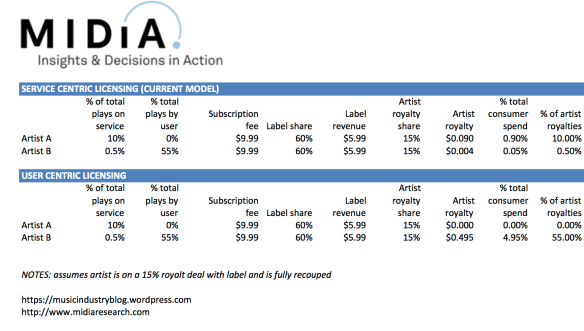User Centric Licensing: Making Streaming Work For Everyone
One of the greatest criticisms surrounding music streaming concerns the reduced income artists receive. This income, based on "airplay," is often miniscule and stretched over a lengthy period of time. Enter user centric licensing.
__________________________________
Guest Post by Mark Mulligan on Music Industry Blog
Under the current licensing model artists get paid on an ‘airplay’ basis i.e. what share of the total plays across the entire service the artist accounts for. This model can skew the revenue balance to the superstars who will get played by a very large share of the user base of a service. Under a user centric model an artist would get paid based on the share of an individual’s listening. So if a user spends half their time listening to an underground techno producer, half of the royalties go to that producer. In the existing model that producer would only get a tiny fraction of the royalties generated by that user.
Let’s take a look at how this could work (see figure). If a subscriber listens to Artist B 55% of the time but that artist only accounts for 0.5% of total listening, only 0.5% of the available royalties for that subscriber make it back to the artist. Whereas Artist A who the user didn’t listen to at all gets 10% of the royalty income. But in a user centric licensing model the artist would get 55%. The revenue changes from a paltry $0.004 to a more meaningful $0.49 (assuming a 15% royalty share from the label). And Artist A gets a fairer zero income for zero listening from that user.
Make no mistake, this model will be very difficult to license and the vested interests would likely resist it. But until we get to scale with subscriptions, we need to explore all ways of ensuring revenues are distributed on as equitable a basis as possible. This approach won’t fix all the artist-income ills of streaming but it will help smooth the transition.
I’m not going to pretend to take credit for this concept, it’s been quietly gaining momentum for some time now and the Trichordist has been building the case too. But now is the time to really start giving this approach some serious consideration. And if the incumbent streaming services are unable to implement user centric licensing because they are too close to the superpowers, then this is an opportunity for a new streaming service to seize the initiative and start to make some meaningful change.

Have you not seen http://www.videscape.com then?